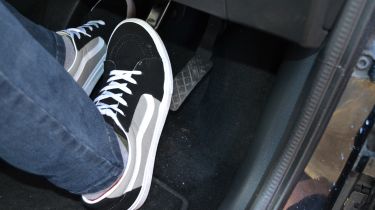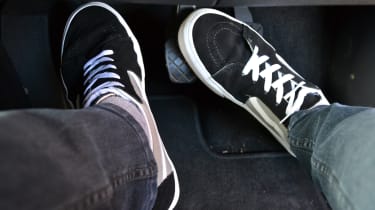What is heel and toe? Rev-matching gear shifts explained
Find out what the term ‘heel and toe’ means and how to use it to make changing gear smoother in a manual car

If you’re interested in becoming a better driver, you may have come across the term ‘heel and toe’ at some point. It’s not quite a commonplace phrase, and it’s often used — especially on internet forums and social media — without explanation.
Here we’ll explain in detail what heel and toe means in the context of driving a car with a manual gearbox. The basic version is that it’s a technique used to make changing gear smoother and easier using the heel and toe of your right foot on the accelerator and brake pedals.
If you’ve driven a manual car you might have noticed that when you change down a gear and bring up the clutch, sometimes there’s a jerk or the car slows suddenly and the engine revs rise sharply as the clutch is disengaged. Using the technique called heel and toe is a perfect way to avoid this, and it reduces wear on the car as well, since this jerking isn’t good for the inside of your gearbox.
Why do you need to heel and toe?
Imagine you’re driving along at 30mph in fourth gear and see a corner ahead. You want to slow slightly and continue to drive around the corner, but know that if you try to accelerate after the corner in fourth gear then your car won’t have enough power. You’d prefer to be in third gear.
The reason for this is that your car’s engine produces more power and torque at higher revs. For example, at 30mph your car’s engine might be at 2,000rpm — revs per minute — in fourth gear, but 3,000rpm in third. That extra 1,000rpm means the engine is producing significantly more power in third gear and the car will be able to accelerate more strongly.

If you simply change down into third gear, however, the engine revs can jump suddenly unsettling the car. The bigger the differential between the engine speed and the road speed, the more pronounced this jerky effect can be. In short, for a smoother downshift the engine speed and the road speed need to closely match.
This is where heel and toe rev-matching comes in, it allows you to make sure that the engine speed is already at the 3,000rpm — in our example —needed to travel at 30mph in third gear. You can do this by pressing the throttle while the clutch is down, but using the heel and toe technique allows you to do so while also slowing the car with the brake.
How do you make a heel and toe gear shift?
Heel and toe gear shifting involves pressing the brake pedal with the toe — or whole upper sole — of your right foot and the accelerator pedal with the heel, while your left foot is on the clutch. This slows the car and raises the engine revs, ready for the clutch to come up and engage a lower gear with no jerkiness.
Heel and toe is probably excessive for use in most on road driving situations because there are few places where the disparity between your road speed and engine speed will be great enough to make it worthwhile. It’s primarily a racing or performance car driving technique that’s used to make sure the car isn’t unsettled by gear shifts while you’re braking hard for a corner. You can use it on the road to make driving smoother as long as you practise in a safe place. Don’t use it on public roads until you are experienced enough that it’s safe and won’t cause you to brake too much or not enough.
Don't miss our next car video, subscribe to our YouTube channel today...



